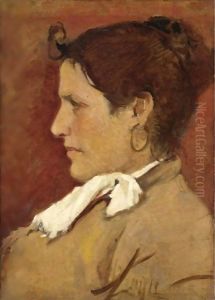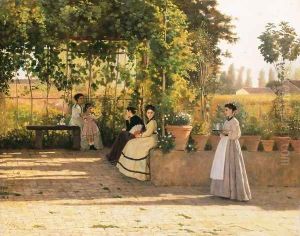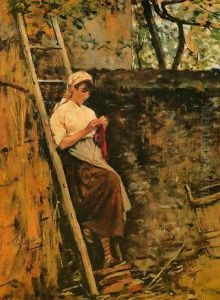Sylvestro Lega Paintings
Sylvestro Lega was a pivotal figure in the Italian Macchiaioli movement, which sought to break away from the formal traditions of painting to embrace a style that was more immediate and realistic, focusing on the play of light and shadow (macchia) and often compared to the French Impressionists for their similar objectives, though the Macchiaioli predated them. Born on December 8, 1826, in Modigliana, Italy, Lega's early life was marked by a passion for art that led him to pursue studies at the esteemed Academy of Fine Arts in Florence. It was here that he was exposed to the revolutionary ideas that would shape his career.
Lega's artistic journey was one of evolution and refinement. Initially influenced by the Romanticism of his time, he was drawn to the Italian landscapes and the everyday life of its people, which became central themes in his work. His early career was marked by a traditional approach to painting, but his style underwent a significant transformation after he joined the Macchiaioli group in the late 1850s. This period was characterized by a shift towards painting en plein air (outdoors), allowing him to capture the transient effects of light with a newfound immediacy and vibrancy.
Throughout the 1860s and 1870s, Lega produced some of his most memorable works, depicting scenes of rural life with a palpable sense of empathy and an eye for the nuanced interplay of light and shadow. His paintings from this period, such as 'Il Pergolato' (The Pergola) and 'La Visita al Frantoio' (Visit to the Oil Mill), showcase his mastery in portraying the mundane aspects of everyday life with a sense of dignity and poetic beauty.
Lega's contribution to the Macchiaioli movement cannot be understated. Along with his contemporaries, he played a crucial role in laying the groundwork for modern Italian painting. Despite the group's lack of formal organization and the diverse styles of its members, they were united in their rejection of academic formalism in favor of a more empirical approach to capturing the essence of their subjects.
Sadly, Lega's later years were marked by personal tragedies and declining health, which led him to retreat from the art world. He died on September 6, 1895, in Florence. Today, Lega is remembered as one of the most important artists of the Macchiaioli movement, with his works held in high esteem and featured in major art collections across Italy and beyond. His legacy is a testament to the enduring appeal of capturing the world through a lens of immediacy and truth, a principle that continues to inspire artists to this day.














